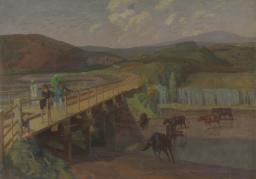E. M., ‘Art Notes’
Illustrated London News, 15 July 1911.
ART NOTES.
The Camden Town group, with Mr. Spencer Gore for President, holds a first exhibition at the Carfax Gallery in Bury Street, St. James’s, three minutes from the Stafford Gallery’s collection of pictures by Mr. Walter Sickert. The group, since it includes Welsh landscapes by Mr. Augustus John, Colchester buttercups by Mr. Lucien Pissarro, and Brittany peasants by Mr. Lamb, breaks the bounds of Mr. Sickert’s territory. Yet the name is the right one. It marks something more than a district of studios; it labels a modern tendency towards the choice of scenes from humble life. Mr. Gore still paints with a rare sense of beauty, and resolutely makes his protest against the æsthetic endeavour for actual beauty of shape and material in daily things. It seems to me that he only postpones the moment of capitulation: he cries “Away with fair and comely sights,” and yields to the fairness and comeliness that is to be found even in a Camden Town bed-sitting-room.
To the Camden Town Group – or Gang, if Mr. Sickert’s “Murder Series” are matters of fact – belong Mr. Sickert himself, Mr. Harold Gilman (whose “The Sofa” is an extraordinarily distinguished piece of painting), Mr. Lamb, and Mr. Lightfoot. Mr. Lamb’s drama, like his decoration, seems to lie outside the district. There is no four-mile radius to his ambition; Mr. Lightfoot seems not quite of the company: technically, his painting has not the interest possessed by that of his fellows; but his sentiment (if he will allow a compliment that sounds so doubtfully in North London) is charming, and his draughtsmanship as interesting as the pigment of his neighbours.
To go from the group to Mr. Walter Sickert at the Stafford Gallery, is to seek the Master, or rather the Old Master. The spaciousness and gravity of his work have never been so clearly shown as in the neighbourhood of his disciples. Mr. Sickert is almost as old as Rembrandt, and if he did not feel acutely his obligations to modernity, he would be twin-brother to the Dutchman. Many painters have attempted a likeness; Mr. Sickert would fly from it. The undercurrent of his colour, a deep-toned brown, is unmatched in modern painting. “Mamma mia poareta” and “Chiacchieramento” are among the most beautiful and touching of these pictures. For Mr. Sickert, like Rembrandt, is an artist of the emotions.
A triple bill, made up of the Bahr collection of Chinese paintings, Mr. Duncan Carse’s fans and a group of coloured engravings, and rather more than a triple bill (for Sem’s delightful caricatures still haunt a back room) is offered by the Fine Art Society. The Chinese paintings are the most important. “Wild Geese and Hibiscus” (Yuan dynasty), “Bamboos” (Ming), and “Lotus and Wild Duck” are admirable works in their class. A portrait said to be of Liu Pei, a Han Emperor (T’ang dynasty, 618–907 A.D.) is impressive in the manner of the greatest European portraiture of the Renascence. – E. M.
How to cite
E. M., ‘Art Notes’, in Illustrated London News, 15 July 1911, in Helena Bonett, Ysanne Holt, Jennifer Mundy (eds.), The Camden Town Group in Context, Tate Research Publication, May 2012, https://www

